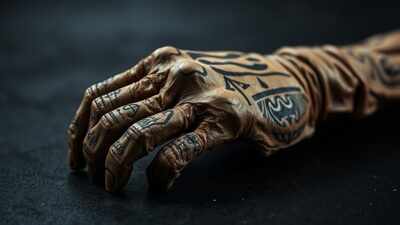
In many cultures, tattoos have long symbolised rebellion or a break from tradition. But for others, they are deeply personal, woven into identity, heritage, and belief. Such was the case for the ancient Pazyryk people.An intricate body art of a 2,500-year-old Siberian “ice mummy” from this nomadic tribe has been uncovered using advanced infrared imaging, offering an extraordinary glimpse into their sophisticated tattooing culture and way of life.Discovered in 1993 on the Okok Plateau in Russia’s Altai Mountains, the mummy is believed to have belonged to a nomadic Pazyryk tribe that roamed the Eurasian plains between the 6th and 3rd centuries BC. Nicknamed as the “Ice Maiden”, the remarkably preserved 50-year-old woman is one of three bodies found frozen in permafrost, her skin still marked with striking inked designs across much of her body.Thanks to high-resolution infrared imaging, researchers have now uncovered a detailed array of animal motifs etched into her skin, including a leopard, stag, rooster and a griffin-like creature.Her arms are adorned with the leopard and stag, a half-lion half-eagle beast rests on her leg, while a rooster is inked onto her thumb, New York Post reported.Gino Caspari, lead researcher from the Max Planck Institute of Geoanthropology, told the BBC, “The insights really drive home to me the point of how sophisticated these people were.”“This made me feel like we were much closer to seeing the people behind the art, how they worked and learned. The images came alive,” he added.Caspari estimated the time and effort involved in tattooing the Ice Maiden, remarking, “If I was guessing, it was probably four and a half hours for the lower half of the right arm, and another five hours for the upper part.”“That’s a solid commitment from the person,” the researcher added.Emphasising the skill involved, Caspari said, “It would need to be performed by a person who knows health and safety, who knows the risks of what happens when the skin is punctured.”The tattoos were created using a process similar to modern techniques, starting with a stencil applied to the skin before the ink was inserted with a needle-like instrument.“And back in the day it was already a really professional practice where people put a lot of time and effort and practice into creating these images and they’re extremely sophisticated.” The study suggests that the tattoos held significance during life rather than in the afterlife, shedding light on the cultural practices and artistry of the Pazyryk tribe.“It suggests that tattoos were really something for the living with meaning during life, but that they didn’t really play much of a role in the afterlife,” Caspari concluded.




